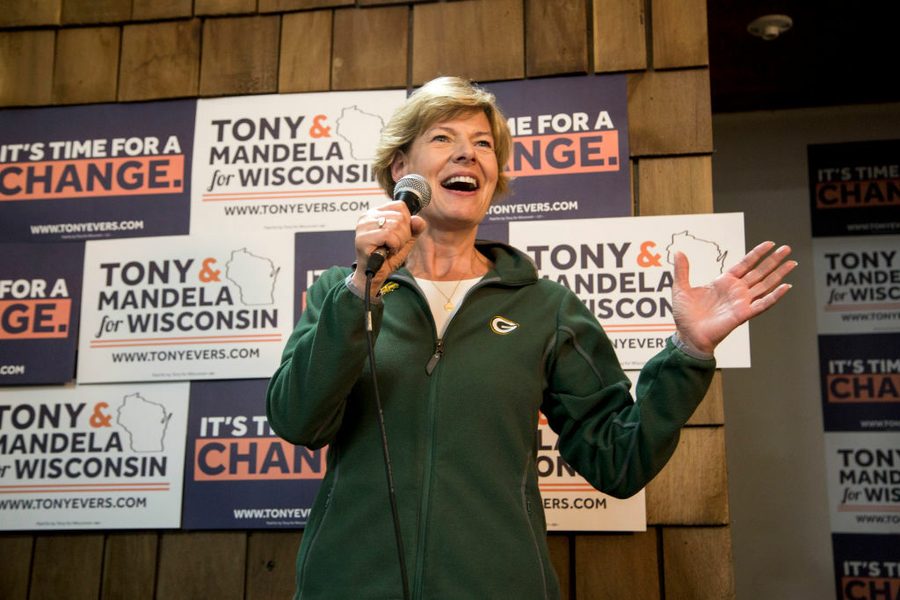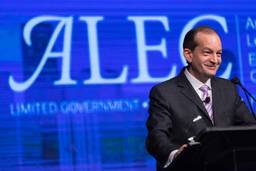The Key to Tammy Baldwin’s Landslide Re-Election? Exposing Her Opponent’s Shady Ties to ALEC
Targeted with $14 million in outside spending, the Wisconsin senator fought back by tagging her opponent as a servant of special interests.
Mary Bottari

U.S. Senator Tammy Baldwin took to the stage for her victory speech on November 6th with Pat Benatar’s “Hit Me With Your Best Shot,” blasting.
Baldwin, the top target of early Koch Brothers attack ads, won big in the state of Wisconsin, crushing her opponent Republican State Senator Leah Vukmir by 11 points. She also garnered 150,000 votes more than Tony Evers, the Democratic nominee for governor who beat Scott Walker by 31,000 votes. This, in a state that had elected Walker three times and gave Trump the 23,000 votes he needed to capture Wisconsin and the White House.
By February, Baldwin had already been the target of $4.5 million in ads from just one Koch front group, Concerned Veterans of America, claiming she dropped the ball on the over-prescription of opioids at the Tomah veteran’s clinic, which resulted in the death of a U.S. Marine. The group ladled on another $1.5 million in July, claiming that she failed to attend important committee meetings. Other ads by the Koch’s Americans for Prosperity and Freedom Partners groups attacked Baldwin over taxes and for “rigging the system against us.”
Baldwin used these early attacks to raise money to respond, and respond she did. The parents and wife of a veteran quickly came to her defense in an ad that effectively put an end to the issue, and Baldwin moved early to define her opponent as a servant of special interests.
Baldwin Ads Used Vukmir’s ALEC Ties to Define Her
Baldwin was the first candidate in a high-profile race that used the American Legislative Exchange Council (ALEC) to effectively frame her opponent as doing the bidding of corporate special interests. The ads capitalize on Leah Vukmir’s long association with the corporate bill mill, where she moved from treasurer to vice president to national chair by 2016. In 2017, she was given an “Iron Lady” award from ALEC, likening the ambitious Vukmir to GOP icon Margaret Thatcher.
The first Baldwin ad introduced ALEC as “a shadowy organization where lobbyists get legislators to introduce their pre-packaged bills. On their national board? Leah Vukmir…,” accompanied by a list of ALEC corporate funders including Pfizer, Exxon, and Koch Industries. Another ad asked “who is Leah Vukmir really?… a national leader of ALEC an organization funded by corporations to lobby state governments,” listing ALEC positions she has taken, including loosening safety standard at nursing homes.
The final ALEC ad highlighted the Center for Media and Democracy’s (CMD) 2013 open records lawsuit against Vukmir that first made headlines when a Vukmir staffer berated, chased, and pushed CMD’s process server to the ground. After claiming that she had no ALEC-related documents in her legislative or personal email, Vukmir ended up coughing up hundreds of emails from ALEC after CMD won its lawsuit.
“Leah Vukmir’s secret, dozens of emails she didn’t want anyone to see,” the ad begins, displaying redacted emails. “Vukmir was sued and forced to release them. She stuck taxpayers with $15,000 in legal bills. What was Vukmir hiding? Emails with lobbyists from ALEC — the shadowy corporate interest group. Instruction for Vukmir to block Medicaid expansion and help the insurance companies. It’s no secret Leah Vukmir’s not for us.” See the ad here. Interestingly, a right-wing dark money group used a very similar ad to attack Vukmir in the primary.
The previously undisclosed records from ALEC’s Spring 2013 meeting show a Florida-based lobbying group instructing Vukmir and other legislators to introduce a bill to thwart Medicaid expansion in the states. The lobbyist even wrote a script explaining the bill for legislators to parrot — contradicting ALEC’s claims to reporters that the organization is “legislator driven.”
It was the most high-profile race to use ALEC effectively, helping to drive Vukmir’s negatives higher throughout the campaign. By election day, she was “the most unpopular politician in the state,” said Tom Russell, an advisor to the Democratic Governor’s Association.
“Research has shown that linking bills or candidates to ALEC tends to significantly decrease support for those bills or candidates, and Tammy Baldwin’s win, and the effectiveness of her ads tying Vukmir to ALEC provides real-world evidence that people respond negatively when they are informed of corporate influence on elected officials,’” said Sam Munger, Director of External Relations for the State Innovation Exchange, a group formed to counter ALEC’s influence in the states. “It helped Tammy make the case that, as her ads said, Vukmir was on the side of special interests and ‘not for us.’”
Courting Ticket Splitters Without Giving Up on Progressive Policies
Baldwin was especially effective at reaching out to the white working class and rural voters, key constituencies that gave Trump a winning margin in 2016. Baldwin flipped 17 of the rural counties that had voted for Trump.
According to Sarah Lloyd, a dairy farmer and the co-chair of the progressive group Our Wisconsin Revolution, Baldwin knew the people and knew the issues most important to rural voters. “Tammy’s office is excellent at constituent services; she knows farmers across the state and can speak fluently about the agricultural issues that are at the heart of Wisconsin’s rural communities.”
Remarkably, exit polls showed that 12 percent of Walker voters voted for Baldwin. This in a state where ticket splitting had been declared dead.
Baldwin has long courted ticket-splitters without giving up on progressive politics. When Baldwin was first elected to the Senate in 2012, she was out early on television with ads stressing themes of the working person, specifically blue collar men who were losing ground in a Wisconsin economy battered by unfair trade deals, a job killing recession, and then by a hostile governor working to put an end to good paying union jobs. She told voters that her opponent, former Governor Tommy Thompson, was “changed” in ads that focused on his lobbying for drug companies and insurance companies.
This cycle, she once again focused on themes and images sure to resonate with working and middle class families. One of Baldwin’s most important narratives featured the work she has done defending Wisconsin’s paper industry, which employs some 53,000 workers, against predatory businesses and unfair trade practices. She has a long track record on these issues both in the House and in the Senate, introducing “Buy America” legislation and challenging Trump to cross the aisle to support it.
“Senator Baldwin has been a consistent fair trade champion, standing up for her state’s workers even when it meant taking on a Democratic president and had led the fight to expand ‘Buy American’ policies so our tax dollars are reinvested to create jobs at home instead of being outsourced,” said Wisconsinite Lori Wallach, the director of Public Citizen’s Global Trade Watch group.
The fair trade theme helped other candidates in the Great Lake states including Sherrod Brown of Ohio, Debbie Stabenow of Michigan and Bob Casey of Pennsylvania. “The 2018 Democratic Senate candidates who won in states that Trump carried are all fair trade champions who fought against job-killing trade agreements, while those who lost supported the corporate-rigged deals,” said Wallach. Brown is now discussing a possible run for the White House.
Health Care Takes Center Stage
But the historical moment clearly benefited Baldwin. Across the country people from both parties told pollsters that health care was their number-one issue, not immigration or the other issues that Republicans attempted to elevate. Ninety-three percent of voters in a Marquette poll put coverage for preexisting conditions at the top of their list of priorities.
On the stump, Baldwin spoke for the first time about a childhood illness she had that made her uninsurable. “I had a serious childhood illness at age nine. It was similar to spinal meningitis … it put me in the hospital for three months,” she explained. “And despite the fact that I fully recovered, my grandparents who raised me were unable to get insurance at any price.”
“This was the perfect election for Tammy,” said Dr. Robert Kraig of Citizen Action Wisconsin, a public interest group that fights to expand health care coverage. “She went into public life because of health care and it has been a priority issue for her entire political career. She worked hard in the Senate to expand the Affordable Care Act, taking great pride in the amendment to allow young people to stay on their parents’ plans until they were 26, and she doesn’t shrink from Medicare for All. I saw her after the election and she was still thrilled about being about to go back to the Senate to work on the issue!”
With her civility, Baldwin differentiated herself from Walker and Trump. “Walker was a polarizing figure right out of the gate in 2011,” said Barry Burden, a Professor in the University of Wisconsin’s Department of Political Science. ‘Since that time, Wisconsin residents have had clear opinions about him and those opinions have divided the state down the middle.”
“Baldwin has taken a different approach to governing,” Burden said. “Although she is an unapologetic progressive, she has not been bombastic or aggressive. In the lead up to 2018 she actually identified a couple of issues where she and President Trump might find common ground. She is a less familiar face than Walker, so as voters learned about her over the course of the campaign they saw a reasonable Senator who seemed to care a great deal about the well-being of Wisconsinites.”
Baldwin rarely mentioned Trump by name and did not cut a single ad talking about Trump.
“The contrast with the way Hillary Clinton campaigned in Wisconsin in 2016 is marked. Tammy ran on bread and butter policies — good wages, good health care — and she didn’t get sidetracked into spending a lot of time taking shots at Trump,” Munger said. “Her campaign and election results prove that when you run on progressive solutions, you can win.”
Making It Personal
But to many CMD interviewed, the key to her secret sauce was her “authenticity” and “genuine warmth” that convinced voters she was on their side. Rarely does an experienced politician run biographical ads deep into her political career and reveal details that the public never knew, but Baldwin did a number of these ads.
While many knew that Baldwin had been raised by her grandparents, the reason for this were never clear. In May, Baldwin revealed that that her mother had passed away after a life-long struggle with opioid addiction. Her ad portrays a child knocking on the front door, but there is no response because the mother is passed out in the house. “I had to grow up fast, very fast, so when I see the opioid crisis wrecking so many Wisconsin families all I can say is that I have been there,” Baldwin says in the affecting ad.
This warm, personal approach stood in stark contrast to the tone set by Leah Vukmir and her campaign.
Former Americans for Prosperity Chief Executive Officer Luke Hilgemann and Chief Operating Office Sean Lansing joined Vukmir’s 2018 U.S. Senate campaign early as senior advisors. Right out of the box, Vukmir set a nasty tone, issuing an attack on May 9 claiming that Baldwin was on “Team Terrorist” and siding with 9/11 mastermind Khalid Sheikh Mohammed for not supporting Trump’s nominee for CIA Director, Gina Haspel. Senator Ron Johnson called it a mistake and the right-wing media outlet Right Wisconsin called the ad “an irresponsible campaign blunder,” but the low blows continued.
She tried to dub Baldwin “Princess Painkiller” and sent out a press release when Senator Elizabeth Warren visited the state entitled “Pocahontas campaigns with Tomah Tammy.” Vukmir’s SuperPAC slammed Baldwin for leading “liberal mobs” during the 2011 Act 10 protests, inadvertently showing video of Baldwin looking young and vibrant.
Vukmir embraced every controversial policy of the Trump administration. While Walker and Paul Ryan made a point to distinguish their campaign rhetoric from Trump’s, Vukmir reveled in Trumpism, pledging to help Trump “build the wall” during Trump’s final rally in the state at Moisinee in October and waving and smiling as the crowd chanted “lock her up,” two years after Clinton lost the election and after four Trump associates had pled guilty to charges from the Special Counsel.
“Vukmir was hindered by a difficult primary battle and her unwavering embrace of Trump,” noted Professor Burden.
The nasty tone undercut Vukmir’s paid ads, which attempted to cast her as a nurse and a mom who cared about Wisconsin families. Vukmir repeatedly claimed that she would “throw herself in front of a bus” to safeguard preexisting condition coverage for Wisconsin families, but her long record of votes on health care came back to haunt her.
Baldwin’s final devastating ad was a roll call of votes taken by the State Senator against expanding health care coverage: “Why would Leah Vukmir vote against hearing aids for children?” “Why? Why?” ask people in the ad repeatedly.
There is no doubt that historic trends in Wisconsin favor a senator in the opposite party of the party in the White House, and Baldwin benefited from a record-breaking turnout approaching 60 percent of voting-age adults (a 70-year high), but her campaign made few stumbles, concentrated on the concerns of working families, defined the candidate and her opponent early, and spoke to voters in rural and urban Wisconsin, providing a blueprint for 2020 candidates.
Reprinted with permission from the Center for Media and Democracy.







